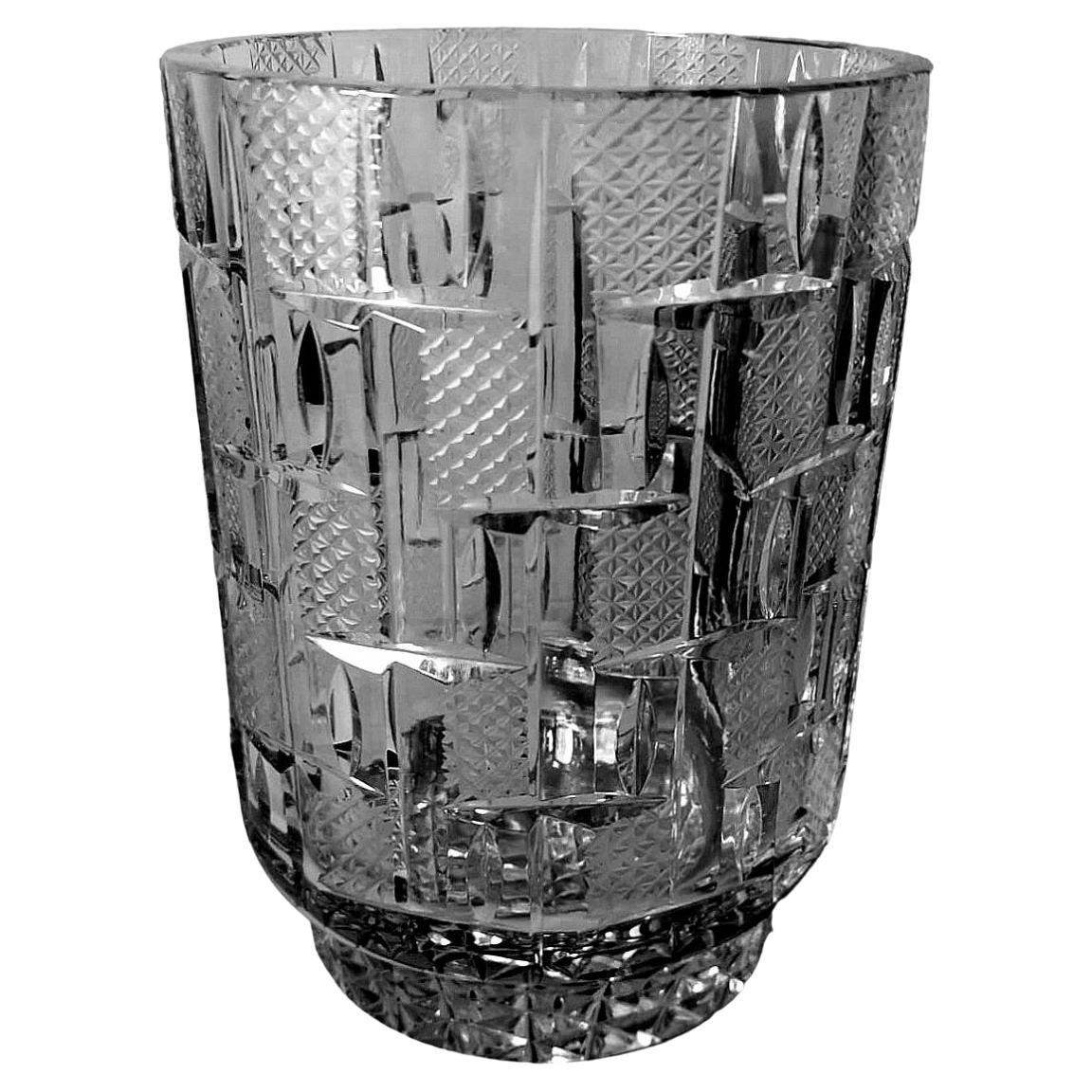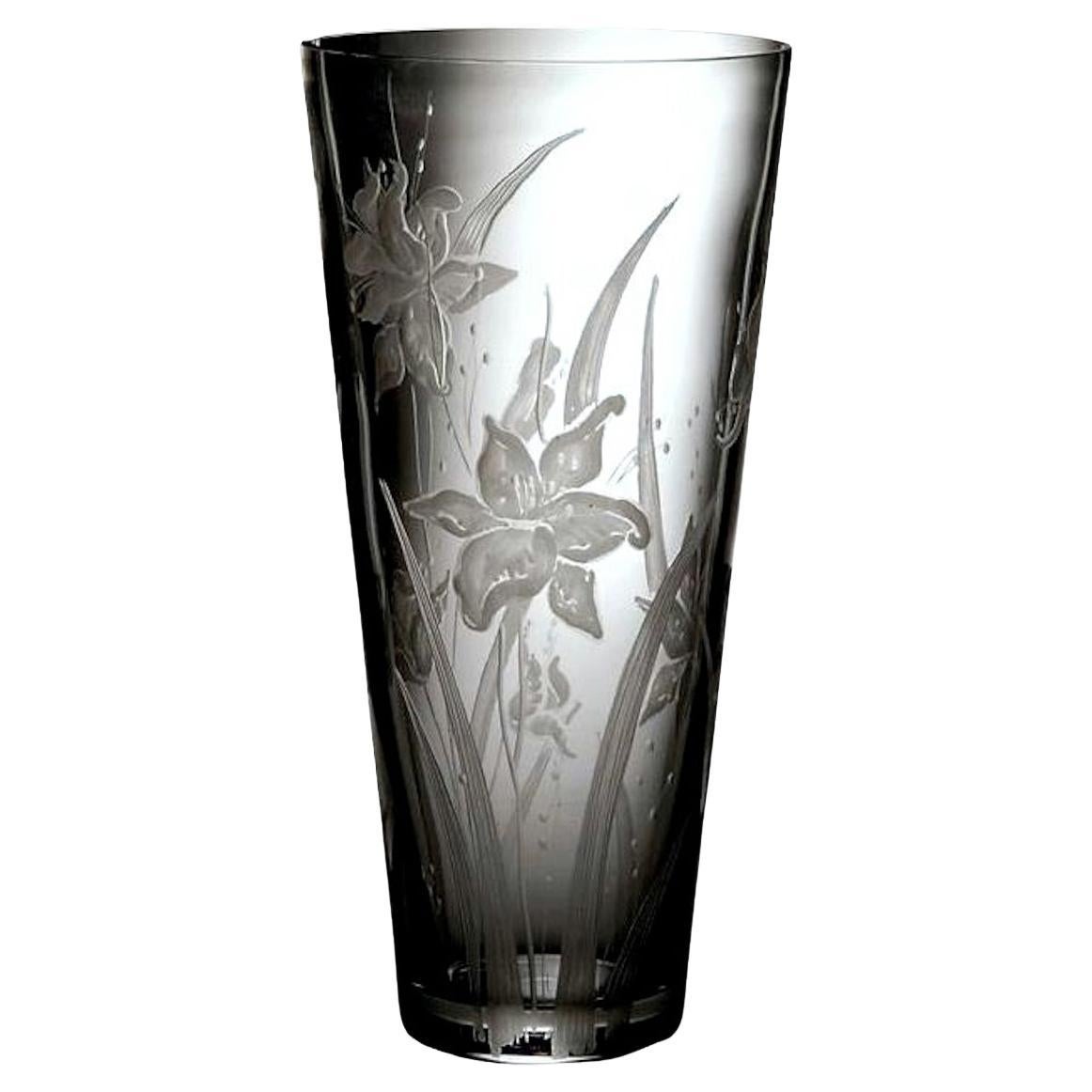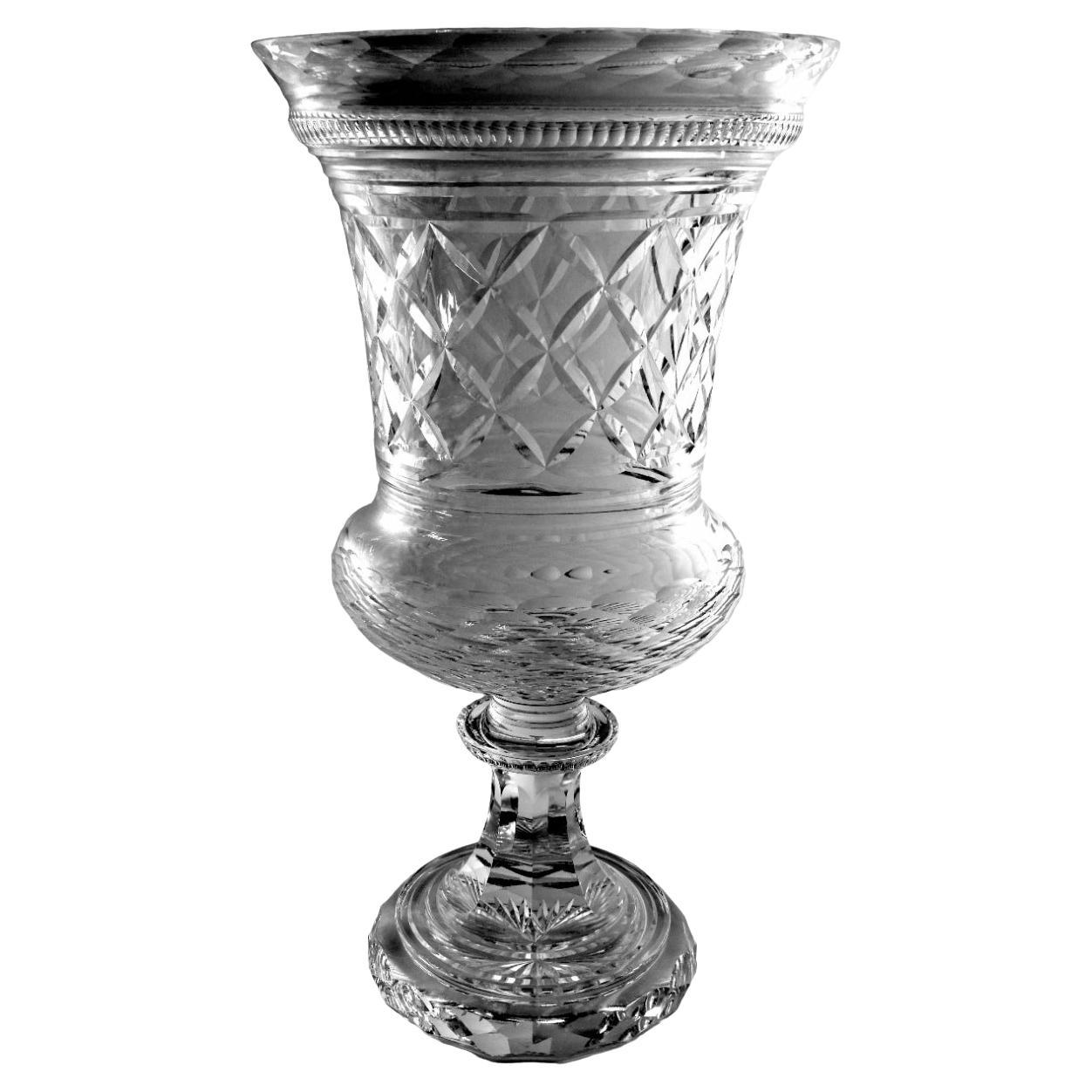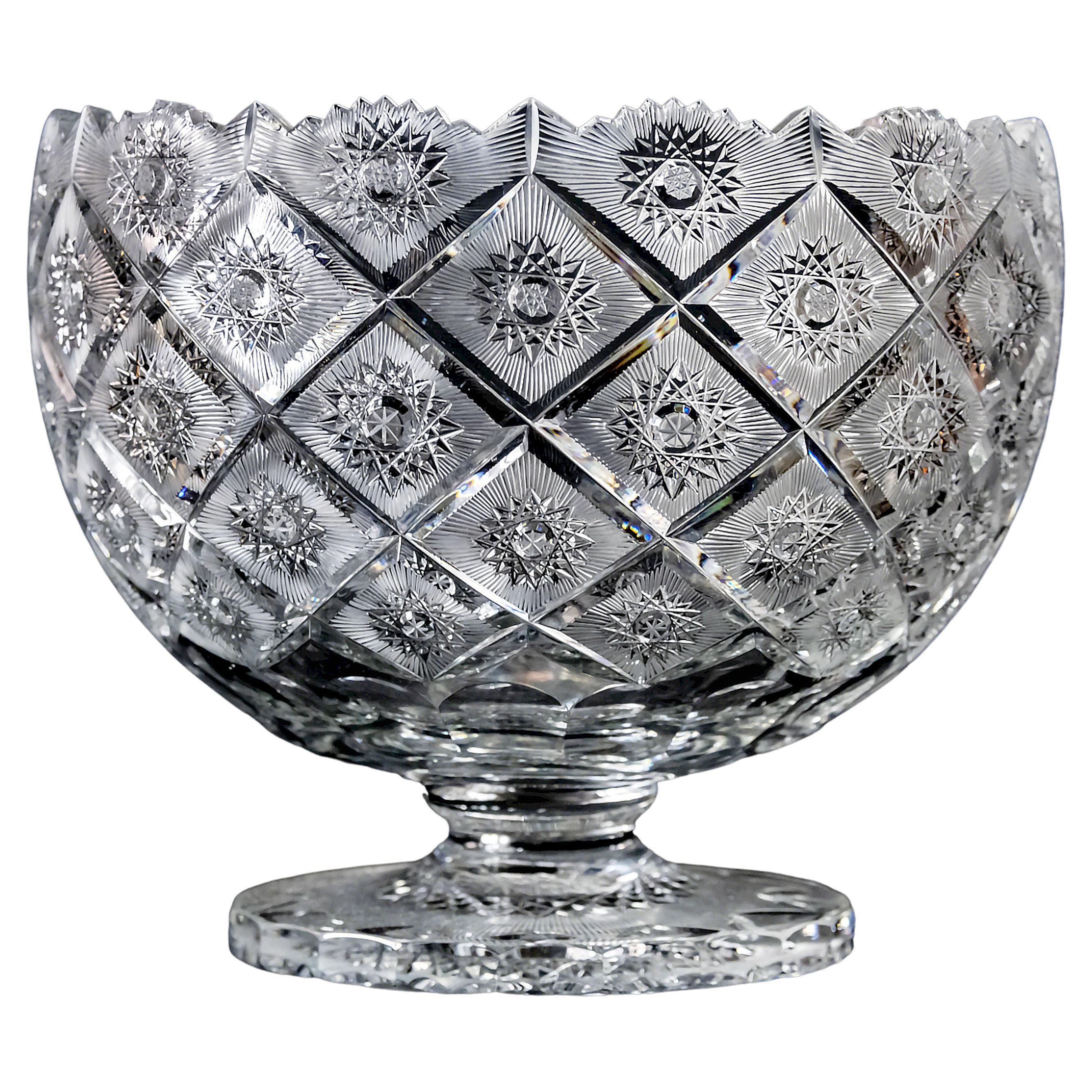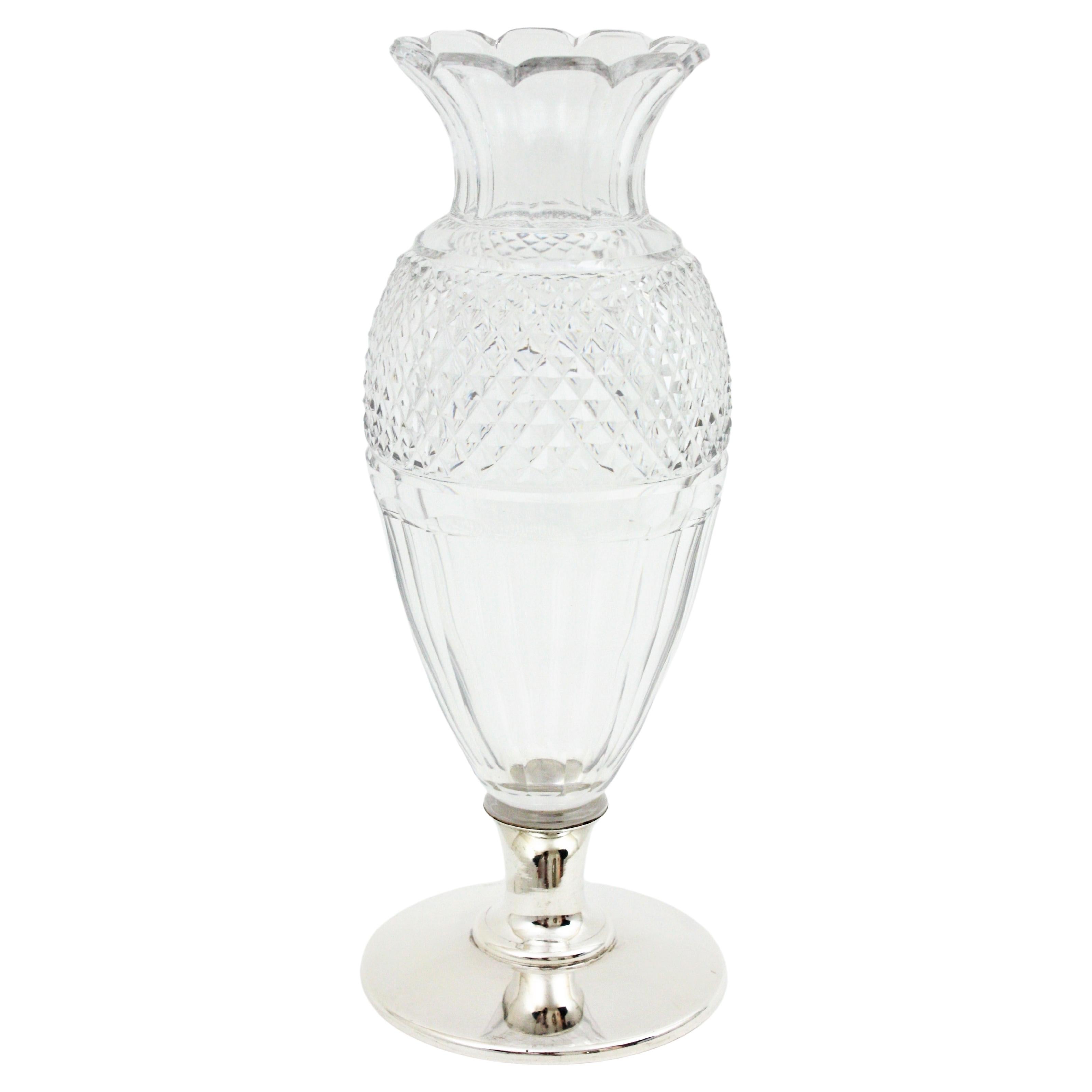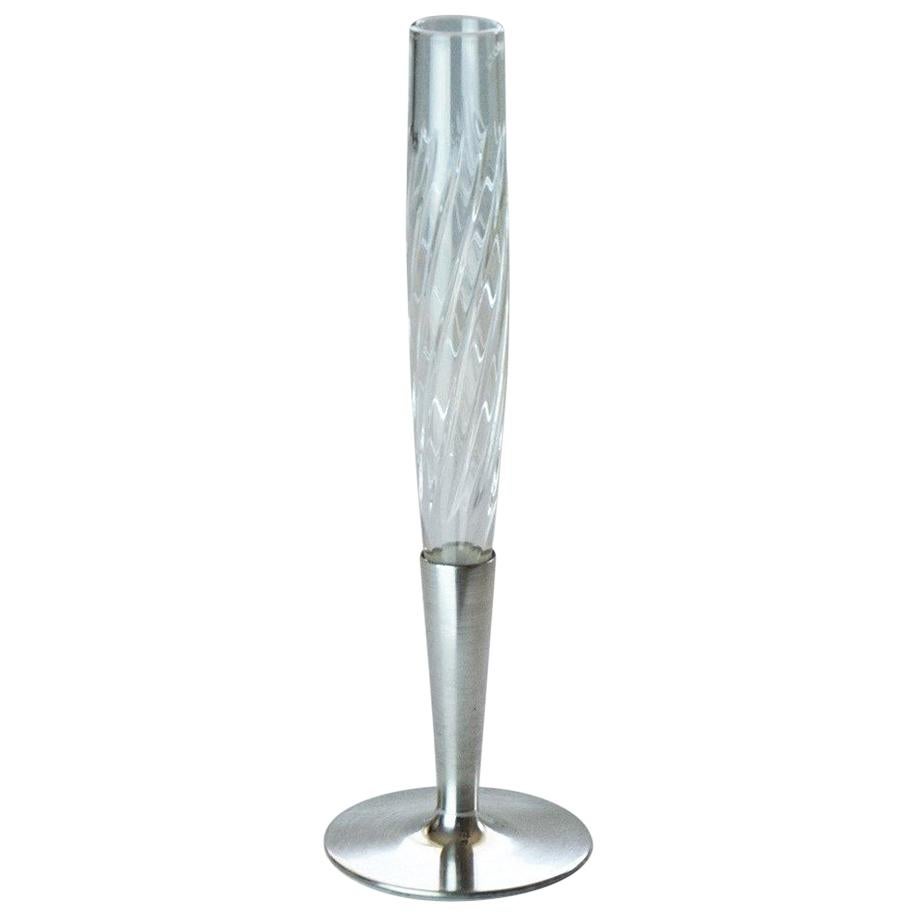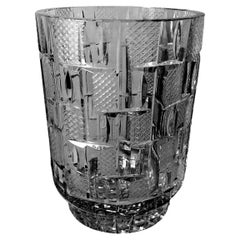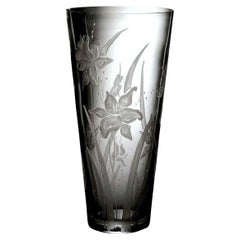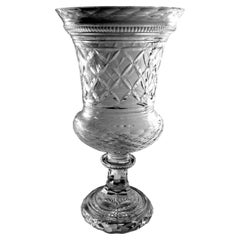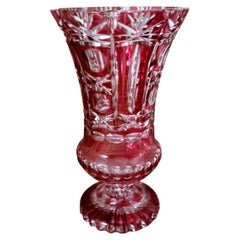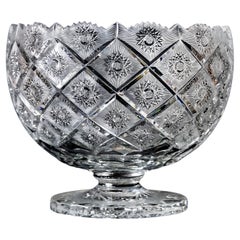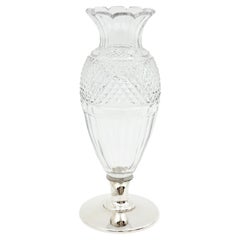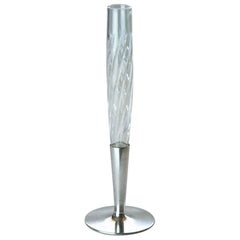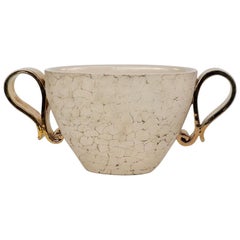Items Similar to Art Deco Large Italian Bi-Color Crystal Vase Cut And Ground By Hand
Want more images or videos?
Request additional images or videos from the seller
1 of 21
Art Deco Large Italian Bi-Color Crystal Vase Cut And Ground By Hand
About the Item
Before describing the object under consideration we must make an important clarification; the artifact, one of many that we will publish over time, is part of the museum collection of a historic Florentine mill that unfortunately closed recently. It is the Marcello Galgani & Figlio company, whose completely manual and artisanal work has not withstood the disproportionate advance of mass-produced mechanical processes! Marcello Galgani began his craftsmanship as a grinder and restorer in 1960; as the years went by, Marcello gained mastery and familiarity with particular techniques and shapes, resulting in the production of objects that manage to retain the freshness of grinding and engraving, the warmth and softness of light, and the inimitable flavor of unique artifacts. After several years, his son Lorenzo, who grew up among crystals, also entered the business and immediately became passionate about this ancient craft with skill and ability. Stimulated by the aesthetic sense of the past, father and son, set up a workshop in which the shapes they researched and created themselves were mouth-blown by traditional Tuscan glassmakers in Empoli, then ground and engraved using ancient sixteenth-century techniques, with motifs born from the inexhaustible imagination of the Galgani family or culturally inspired by designs of objects seen and studied in Florentine museums (Uffizi, Galleria Palatina, Museo degli Argenti, etc.). As mentioned the company recently closed and disposed of all its last production, only Marcello's old private museum collection remained, which includes unique and special objects created over time, a collection that the craftsman made available to us for a planned sale. All of the objects were made entirely by hand with old grinding wheels, but there were mainly two tools that allowed the creation of masterpieces: the right hand and the left hand of the master craftsman. Ancient glassmaking techniques were used for all the ground and engraved products: first the object was ground with an emery wheel fed continuously by a jet of abrasive sand and water, then re-polished with a very fine-grained sandstone wheel also fed with water; the engravings were done freehand using as many as 10-15 small stone wheels for each design (flowers, branches, animals, etc.); then the object was polished and polished. We must make, at this point, an important clarification about these last two operations: towards the end of the 1960s, acid crystal polishing was devised, the object was immersed and rotated in a solution of sulfuric acid, fluoridic acid, and water and in a short time all the defects left by the previous processes were eliminated, it was a fast, industrial operation that allowed to lower costs considerably, with discrete but not excellent results. But for Galgani's products polishing is done with a cork bark wheel wet with water and pumice, to make the surfaces more transparent, finally, polishing was achieved with a felt wheel wet with a paste of water, iron oxide, and cerium oxide. This series of processes takes an average of two days of work ( sometimes much longer) for each object; each engraving or grinding is the result of the creative inventiveness of the two craftsmen, inventiveness that transforms crystal into a material reality of the highest aesthetic value and inestimable worth. All objects in the entire collection have never been used; they were part of the exhibition. Large blue and amber Art Deco-style vase; the vase was produced in a kiln in Empoli (Italy) using the technique of "incamiciatura," which consists of superimposing on the glass mass, in the first stage of processing, one or more successive layers of glass of various colors; in our vase the amber-colored mass was superimposed on the blue color; the cutting and grinding performed afterward revealed the underlying amber color, creating an unparalleled work of art; Master Marcello personally ground the horse figure with exceptional artistic dexterity, then sandblasted to enhance the depth of grinding. The complex stages of fabrication took 7 days to complete. The object was created in Marcello Galgani's workshop in 1984 and made with the techniques (grinding, engraving, and polishing) we explained in the introductory description. Only two examples of this object are available. Measures diameter cm.23. height cm.33. The vase is in excellent condition. For all our shipments we use special packaging materials (wooden crates, styrofoam, etc.) for maximum protection and safety of the objects.
- Dimensions:Height: 13 in (33 cm)Diameter: 9.06 in (23 cm)
- Style:Art Deco (In the Style Of)
- Materials and Techniques:
- Place of Origin:
- Period:
- Date of Manufacture:1984
- Condition:The item is in excellent condition. All items in the entire collection have never been used; it was part of the exhibition.
- Seller Location:Prato, IT
- Reference Number:Seller: MG-3581stDibs: LU4632239225932
About the Seller
5.0
Gold Seller
Premium sellers maintaining a 4.3+ rating and 24-hour response times
Established in 1977
1stDibs seller since 2019
275 sales on 1stDibs
Typical response time: 1 hour
- ShippingRetrieving quote...Shipping from: PRATO, Italy
- Return Policy
Authenticity Guarantee
In the unlikely event there’s an issue with an item’s authenticity, contact us within 1 year for a full refund. DetailsMoney-Back Guarantee
If your item is not as described, is damaged in transit, or does not arrive, contact us within 7 days for a full refund. Details24-Hour Cancellation
You have a 24-hour grace period in which to reconsider your purchase, with no questions asked.Vetted Professional Sellers
Our world-class sellers must adhere to strict standards for service and quality, maintaining the integrity of our listings.Price-Match Guarantee
If you find that a seller listed the same item for a lower price elsewhere, we’ll match it.Trusted Global Delivery
Our best-in-class carrier network provides specialized shipping options worldwide, including custom delivery.More From This Seller
View AllItalian Midcentury Large Crystal Vase Ground, Cut, And Polished By Hand
Located in Prato, Tuscany
Please kindly read the entire description, as we aim to provide you with detailed technical and historical information to ensure the authenticity of our objects.
This exceptional Ita...
Category
Late 20th Century Italian Mid-Century Modern Vases
Materials
Crystal
Italian Cut And Ground Crystal Vase With Flower Decoration
Located in Prato, Tuscany
Before describing the object under consideration we must make an important clarification; the artifact, one of many that we will publish over time, is part of the museum collection o...
Category
Late 20th Century Italian Mid-Century Modern Vases
Materials
Crystal
Florentine Renaissance Style Huge Italian Cut And Ground Crystal Medici Vase
Located in Prato, Tuscany
Before describing the object under consideration, we must make an important clarification; the artifact, one of many that we will publish over time, is part of the museum collection of a historic Florentine crystal grinder that unfortunately closed recently. It is the Marcello Galgani & Son company, whose completely manual and artisanal work has not withstood the disproportionate advance of mass-produced mechanical processes! Marcello Galgani began his craft as a grinder and restorer in 1960; as the years went by, Marcello mastered and became familiar with particular techniques and shapes, resulting in the production of objects that manage to retain the freshness of grinding and engraving, the warmth and softness of light, and the inimitable flavor of unique artifacts. After several years, his son Lorenzo, who grew up among crystals, also entered the business and immediately became passionate about this ancient craft with skill and ability. Stimulated by the aesthetic sense of the past, father and son, set up a workshop in which the shapes they researched and created themselves are mouth-blown by traditional Tuscan glassmakers in Empoli, then ground and engraved using ancient sixteenth-century techniques, with motifs born from the Galgani's inexhaustible imagination or culturally inspired by designs of objects seen and studied in Florentine museums (Uffizi, Galleria Palatina, Museo degli Argenti, etc.). Marcello and Lorenzo Galgani were also Masters in the difficult art of restoration, bringing rare and precious objects back to life. As mentioned the company recently closed and disposed of all its last production, and only Marcello's old private museum collection remained, which includes unique and special objects created over time, a collection that the craftsman made available to us for a planned sale. All of the objects were made entirely by hand with old grinding wheels, but there were mainly two tools that allowed the creation of masterpieces: the right hand and the left hand of the master craftsman. Ancient glassmaking techniques were used for all the ground and engraved products: first, the object was ground with an emery wheel fed continuously by a jet of abrasive sand and water, then re-polished with a very fine-grained sandstone wheel also fed with water; the engravings were done freehand using as many as 10-15 small stone wheels for each design (flowers, branches, animals, etc. ); then the object was polished and shined; we must make, at this point, an important clarification on these last two operations: towards the end of the 1960s acid crystal polishing was devised, the object was immersed and rotated in a solution of sulfuric acid, fluoridic acid and water and in a short time all the defects left by the previous processes were eliminated, it was a fast, industrial operation that allowed to lower costs considerably, with discrete but not excellent results. But for Galgani's products polishing is done with a cork bark wheel wet with water and pumice, to make the surfaces more transparent, and finally polishing was achieved with a felt wheel wet with a paste of water, iron oxide, and cerium oxide. This series of processes takes an average of two days of work( sometimes much longer) for each object, each engraving or grinding is the result of the creative inventiveness of the two artisans, inventiveness that transforms crystal into reality material of the highest aesthetic value and inestimable value. All the items in the entire collection have never been used; they were part of the exhibition. Huge and monumental Florentine Renaissance-style vase...
Category
Late 20th Century Italian Renaissance Vases
Materials
Crystal
Biedermeier Style Bohemia Cut And Ground Red Crystal Vase
Located in Prato, Tuscany
We kindly suggest that you read the entire description, as with it we try to give you detailed technical and historical information to ensure the authenticity of our objects.
Delight...
Category
Mid-20th Century Czech Biedermeier Vases
Materials
Crystal
$693 Sale Price
20% Off
Italian Craftsmanship Hand-Cut and Hand-Polished Beveled Crystal Vase
Located in Prato, Tuscany
We kindly suggest that you read the entire description, as we aim to provide detailed technical and historical information to guarantee the authenticity of our objects. This exceptio...
Category
Late 20th Century Italian Modern Vases
Materials
Crystal
Neoclassical Style Italian Chalice-Shaped Vase in Ground and Diamond Crystal
Located in Prato, Tuscany
Before describing the object under consideration, we must make an important clarification; the artifact, one of many that we will publish over time, is part of the museum collection ...
Category
Late 20th Century Italian Neoclassical Vases
Materials
Crystal
You May Also Like
Large Hand-Cut Crystal Vase Centerpiece
Located in Vilnius, LT
Vintage large and heavy cut crystal vase centerpiece.
The crystal is very clear and gives off a bright sound.
Very good/excellent condition.
Category
Mid-20th Century Italian Mid-Century Modern Glass
Materials
Crystal
Spanish Art Deco Cut Crystal and Silver Urn Vase
Located in Barcelona, ES
Cut crystal vase with silver base, Spain, 1930s-1940s.
Elegant urn shaped crystal vase manufactured at the late Art Deco period.
Finely executed with very detailed hand-cut crystal patterns...
Category
20th Century Spanish Art Deco Vases
Materials
Crystal, Silver
$1,387 Sale Price
20% Off
Art Deco Cut Crystal and Sterling Silver Solitary Vase
Located in Frankfurt am Main, DE
A Lovely Art Deco silver solitary of beautifully handcut crystal and sterling silver by Topázio, Portugal, circa 1930-1935.
Hallmarked: Topázio poincon.
Measures: Height 8.75 in (2...
Category
Mid-20th Century Portuguese Art Deco Vases
Materials
Crystal, Sterling Silver
Large Art Deco Vase by Kaza
By Kaza
Located in CA, CA
A beautiful 1930s large ceramic vase by Kaza with dramatic gold glazed handles
The unglazed hand pressed body has a glazed interior and gilt scrolled handles stamped Kaza, France to...
Category
Vintage 1930s French Art Deco Vases
Materials
Ceramic
Hand-Cut Bohemian Crystal Vase
Located in Marbella, ES
Hand-Cut bohemian crystal vase
Category
Late 20th Century Czech Glass
Materials
Glass, Art Glass
$1,664 Sale Price
20% Off
Art Deco Lidded Cut and Etched Crystal Bottles by Moser
By Moser Glassworks
Located in New York, NY
A pair of period Art Deco cut crystal lidded light lavender grey Art Deco lidded bottles. These fabulous bottles are ovoid forms with lozenge cut bases g...
Category
Vintage 1930s Czech Art Deco Bottles
Materials
Crystal
Recently Viewed
View AllMore Ways To Browse
Art Deco Industrial Light
Cork Family
Large Cut Colored Glass
Wooden Grain Measurer
Empoli Blown
Vintage Wooden Wheel
Empoli Art Glass
Vintage Glass Grinder
Horse On Wheels
Hand Colored Engravings Vases
Mechanical Horse
Sulfur Crystal
Vintage Amber Water Glasses
Vintage Horse On Wheels
James Nowak Glass
Jim And Connie Grant
Joel Meyers
John Ffrench
